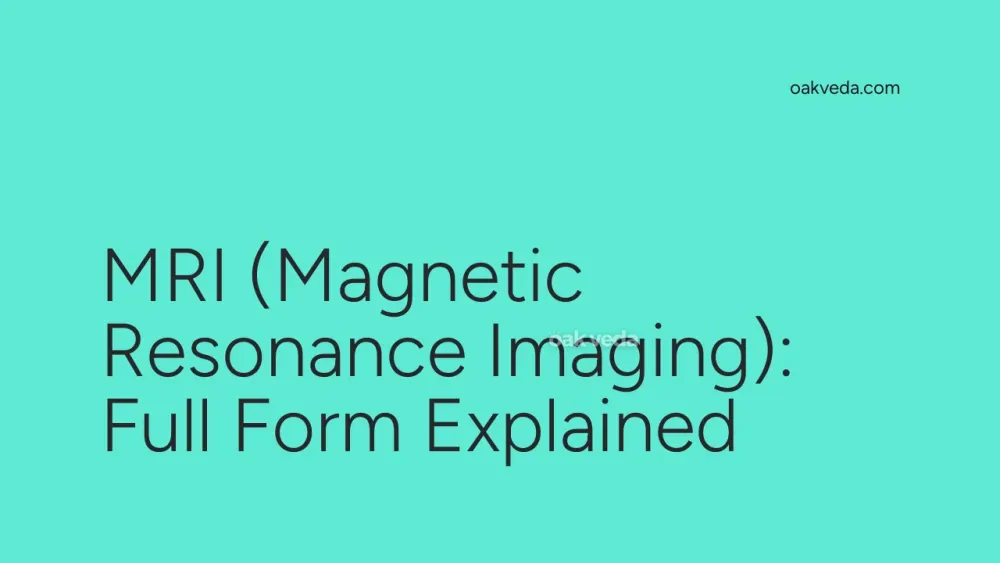
What is the Full Form of MRI?
The full form of MRI is Magnetic Resonance Imaging. This advanced medical imaging technique has revolutionized the field of diagnostic radiology, providing detailed images of the body's internal structures without the use of ionizing radiation.
What is Magnetic Resonance Imaging?
Magnetic Resonance Imaging, commonly known as MRI, is a non-invasive diagnostic imaging technology that uses powerful magnets and radio waves to create detailed cross-sectional images of the body's organs and tissues. Unlike X-rays or CT scans, MRI does not use ionizing radiation, making it a safer option for repeated examinations.
Origin and Development of Magnetic Resonance Imaging
The principles behind MRI were first discovered in the 1940s, but it wasn't until the 1970s that the technology was applied to medical imaging. Dr. Raymond Damadian is credited with the first MRI scan of a human body in 1977. Since then, MRI technology has rapidly evolved, becoming an essential tool in modern medicine.
How does Magnetic Resonance Imaging work?
MRI scanners typically consist of a large, tube-shaped magnet. The process works as follows:
- The patient lies inside the MRI machine, which contains a powerful magnetic field.
- This magnetic field causes hydrogen atoms in the body's water molecules to align.
- Radio waves are then pulsed through the body, causing these aligned atoms to produce faint signals.
- The MRI scanner detects these signals and uses them to create detailed cross-sectional images.
- A computer processes these signals to generate 3D images of the body's internal structures.
Types of Magnetic Resonance Imaging
There are several types of MRI scans, each designed for specific diagnostic purposes:
- Functional MRI (fMRI): Measures brain activity by detecting changes in blood flow.
- Diffusion MRI: Tracks the movement of water molecules in the brain, useful for diagnosing strokes.
- Magnetic Resonance Angiography (MRA): Visualizes blood vessels without using contrast dyes.
- Cardiac MRI: Provides detailed images of the heart's structure and function.
Functions of Magnetic Resonance Imaging
The primary function of MRI is to provide detailed images of the body's internal structures. It excels at:
- Differentiating between various types of soft tissue
- Detecting subtle changes in organs and tissues
- Providing information about blood flow and fluid movement
- Guiding surgical procedures and treatment planning
Applications of Magnetic Resonance Imaging
MRI has a wide range of applications in medical diagnosis and research:
- Neurological disorders: Detecting brain tumors, stroke, multiple sclerosis, and spinal cord injuries.
- Musculoskeletal system: Diagnosing joint problems, sports injuries, and bone tumors.
- Cardiovascular system: Assessing heart structure and function, detecting aneurysms.
- Cancer diagnosis and monitoring: Identifying tumors and tracking treatment progress.
- Gastrointestinal and liver diseases: Detecting liver tumors, cirrhosis, and inflammatory bowel diseases.
- Women's health: Evaluating uterine abnormalities and breast cancer.
Features of Magnetic Resonance Imaging
MRI offers several unique features that set it apart from other imaging techniques:
- High-resolution images: Provides detailed views of soft tissues, organs, and bones.
- Multi-planar imaging: Can produce images in any plane without moving the patient.
- No ionizing radiation: Safer for repeated examinations and pediatric patients.
- Contrast manipulation: Allows for enhancement of specific tissues or abnormalities.
- Functional imaging: Can assess organ function and blood flow.
Benefits of Magnetic Resonance Imaging
MRI offers numerous benefits in medical diagnosis and treatment:
- Non-invasive and painless procedure
- No exposure to ionizing radiation
- Excellent soft tissue contrast
- Ability to detect diseases at early stages
- Helps in accurate treatment planning
- Can be used to monitor treatment effectiveness
Limitations or Challenges of Magnetic Resonance Imaging
Despite its many advantages, MRI does have some limitations:
- High cost of equipment and examinations
- Long scanning times compared to other imaging techniques
- Claustrophobia in some patients due to the enclosed scanner
- Cannot be used for patients with certain metal implants or devices
- Motion artifacts can affect image quality
- Limited availability in some regions
Future Developments in Magnetic Resonance Imaging Technology
The field of MRI continues to evolve, with several exciting developments on the horizon:
- Ultra-high field MRI: Scanners with stronger magnetic fields for even more detailed images.
- Artificial Intelligence integration: AI-assisted image analysis for faster and more accurate diagnoses.
- Portable MRI devices: Smaller, more accessible MRI machines for point-of-care diagnostics.
- Hyperpolarized MRI: Enhanced imaging of metabolic processes in real-time.
- Silent MRI technology: Reducing noise levels for improved patient comfort.
FAQs on MRI Full Form
-
What is the difference between MRI and CT scans? MRI uses magnetic fields and radio waves, while CT scans use X-rays. MRI provides better soft tissue contrast and doesn't use ionizing radiation.
-
Is MRI safe during pregnancy? While MRI is generally considered safe during pregnancy, it's usually avoided in the first trimester unless absolutely necessary.
-
How long does an MRI scan take? The duration varies depending on the area being scanned, but typically ranges from 15 to 90 minutes.
-
Are there any alternatives to MRI for claustrophobic patients? Open MRI scanners are available for claustrophobic patients, though they may not provide the same image quality as traditional closed scanners.
-
Can MRI detect all types of cancer? While MRI is excellent at detecting many types of cancer, it's not 100% accurate for all cancers. Other diagnostic tools may be used in conjunction with MRI for comprehensive evaluation.
In conclusion, Magnetic Resonance Imaging, the full form of MRI, has become an indispensable tool in modern medicine. Its ability to provide detailed, non-invasive imaging of the body's internal structures continues to advance our understanding of human health and disease, paving the way for more accurate diagnoses and effective treatments.
You may be interested in:
- B.Ed (Bachelor of Education): Full Form and Guide
- NIFTY (Full Form): National Stock Exchange Fifty
- CNC (Computerised Numerical Control) Full Form
- AAI (Airport Authority of India): Full Form Explained
- CRISIL (Credit Rating Information Services of India Limited)
- CVC (Central Vigilance Commission) Full Form

